Abstract
Objectives
The objectives of this study were: (1) to develop a laboratory-based model to assess fear and anxiety in cats using the feline open-field test (OFT) and the feline human interaction test (HIT); and (2) to validate the model using diazepam, a known anxiolytic.
Methods
Laboratory-housed cats (n = 41) were first classified as fearful, mildly fearful or non-fearful by a technician familiar with the cats and also by veterinary behaviorists (GL, JL), by assessing the cats’ behavior in their home rooms. In experiment 1, each cat’s behavior was assessed in an OFT and an HIT. In experiment 2, after administration of the anxiolytic diazepam, a subset of the cats was re-tested.
Results
In experiment 1, the OFT revealed significant group effects on two measures: duration of inactivity, and vocalization. Fearful animals had significantly longer periods of inactivity than non-fearful animals. Non-fearful and mildly fearful cats vocalized more frequently than fearful cats. In the HIT, fearful cats travelled less than non-fearful and mildly fearful cats. Fearful and mildly fearful animals had significantly longer durations of inactivity, and non-fearful and mildly fearful cats had a significantly higher frequency of vocalization compared with fearful cats. In experiment 2, in the OFT, treatment with diazepam caused an increase in distance travelled, shorter durations of inactivity, and more frequent inactivity and vocalization. In the HIT, diazepam increased distance travelled and decreased duration of inactivity. Fearful cats spent significantly less time near the human compared with non-fearful cats, and this persisted under diazepam.
Conclusions and relevance
The feline OFT and feline HIT can be used jointly to assess the effects of medications or other therapies on fear and anxiety in the domestic cat.
Introduction
Many feline behavior problems arise from excessive fear and anxiety, which negatively affect the pet’s health and welfare, and the pet–owner dynamic.1,2 These feline behavior problems require medication in combination with behavior modification for effective management. 1 However, no pharmacologic agents have received regulatory approval for the treatment of anxiety in cats. While a variety of natural products have claimed to be effective, these have not been comprehensively assessed. The experiments in this study sought to develop a validated laboratory model to study fear and anxiety in laboratory cats.
A major issue in developing therapeutics for treatment of anxiety and fear is the availability of validated assessment models in the target species for conducting clinical trials. Previous approaches have focused on both broad-based subjective anxiety measures and measures of specific signs, such as urine marking.3–6 However, none has distinguished between anxiety and fear as separate emotional states.
Fear and anxiety are negative emotional states that help the individual to protect itself from harm. Fear is a state of alarm or agitation that is linked to a precipitating stimulus. 7 Anxiety, by contrast, is an emotional state that lacks a specific triggering event.8,9 Typical signs of excessive fear and anxiety include autonomic activation and behaviors such as aggression, hiding, escaping, freezing and house-soiling.7,8 The two emotions are separate and can co-exist in an individual at any one time and while they share similarities in causing autonomic activation, separation of the two emotional states can be objectively measured in a laboratory setting. The open-field test (OFT) has been used to assess anxiety in several species, including rodents, cows, horses, sheep and dogs.10–14 In the OFT, anxiety is typically associated with inactivity and avoidance of open spaces in the test arena. The human interaction test (HIT) has previously been tested in dogs and cats. 14 For example, the HIT was used as a validation test for the feline temperament test. 15 Cats with ‘acceptable’ (desirable) temperament scores were likely to approach an unfamiliar person in open-field testing, while cats with ‘questionable’ (undesirable) scores spent more time away from people. In our study, experiment 1 examined the behavior response of cats differing in levels of fearfulness in a feline OFT and a feline HIT.
The distinction between anxiety and fear is supported pharmacologically by research with rodents. Panicolytic medications (ie, drugs that are fear reducing, such as chronic alprazolam or fluoxetine) reduce flight behaviors that are associated with fear in response to the presence of a predator.16,17 Anxiolytic medications (eg, benzodiazepines), however, reduce ‘risk assessment’ in response to the odor of a predator.18,19 Panicolytic medications do not affect anxiety-related behavior and vice versa for anxiolytic medication.16,17
The goal of the current study was to develop a validated laboratory-based protocol for objectively quantifying fear and anxiety in laboratory cats. In experiment 1, the OFT and the HIT were used to characterize the behavior of cats categorized by three different levels of fearfulness. We hypothesized that anxious cats would have increased levels of inactivity. Experiment 2 focused on the response to placement in the OFT and HIT after treatment with an anxiolytic, diazepam.8,17,20 We hypothesized that measures of anxiety and fear in the fearful cats would be reduced after treatment.
Materials and methods
Cats
Cats (n = 41) were male and female (aged 1.79–11.49 years) domestic shorthaired cats from the Vivocore colony (see Table 1). The animals were originally obtained from a variety of sources, including commercial breeders, in-house breeding and from other laboratory colonies. However, all cats had been housed in the Vivocore facility for >6 months, and were deemed healthy by the facility veterinarian. In addition, we did not accept any cats with a body condition score in the obese range or any other condition that would negatively affect mobility. Cats were group housed based on compatibility, with a maximum of 24 animals per room, in rooms measuring approximately 4.3 m × 3.1 m. Cats were fed a balanced dry ration ad libitum (Purina Pro Plan).
Table 1.
Study cats
| Cat | Fear rating | Sex | Age (years) | Neutered |
|---|---|---|---|---|
| Ace | Non-fearful | M | 3.90 | Yes |
| Alexandra | Non-fearful | F | 3.90 | Yes |
| Aya | Fearful | F | 4.70 | Yes |
| Commander | Non-fearful | M | 4.19 | Yes |
| Constance | Mildly fearful | F | 3.83 | No |
| Darrin | Non-fearful | M | 4.10 | Yes |
| Gael | Fearful | M | 4.65 | Yes |
| Hazel | Non-fearful | F | 1.88 | Yes |
| Herman | Fearful | M | 4.65 | Yes |
| Iris | Fearful | F | 4.70 | Yes |
| Jackie | Mildly fearful | F | 5.61 | Yes |
| Joker | Non-fearful | M | 3.79 | Yes |
| Joy | Non-fearful | F | 4.07 | Yes |
| Katniss | Mildly fearful | F | 4.82 | Yes |
| Lacey | Mildly fearful | F | 5.60 | No |
| Larisa | Mildly fearful | F | 3.99 | No |
| Licorice | Non-fearful | F | 3.72 | No |
| Masha | Mildly fearful | F | 5.63 | No |
| Melanie | Mildly fearful | F | 3.68 | Yes |
| Mimi | Mildly fearful | F | 3.88 | No |
| Mina | Fearful | F | 5.06 | Yes |
| Mocha | Non-fearful | F | 3.94 | No |
| Morgan | Non-fearful | M | 3.91 | Yes |
| Nabee | Non-fearful | F | 5.36 | Yes |
| Othello | Non-fearful | M | 1.79 | Yes |
| Paddy | Non-fearful | F | 5.51 | No |
| Peeta | Fearful | M | 4.65 | Yes |
| Pepper | Non-fearful | F | 1.85 | Yes |
| Philip | Non-fearful | M | 4.37 | Yes |
| Pint | Non-fearful | M | 3.89 | Yes |
| Prudence | Fearful | F | 4.70 | Yes |
| Ruby | Mildly fearful | F | 5.61 | No |
| Salt | Non-fearful | M | 1.87 | Yes |
| Seymour | Non-fearful | M | 1.89 | Yes |
| Slash | Fearful | M | 4.70 | Yes |
| Solomon | Non-fearful | M | 3.72 | Yes |
| Star | Non-fearful | F | 3.87 | No |
| Statia | Non-fearful | F | 11.49 | Yes |
| Tank | Non-fearful | M | 4.26 | Yes |
| Thor | Non-fearful | M | 4.26 | Yes |
| Wasabi | Non-fearful | M | 2.49 | Yes |
M = male; F = female
Ratings of fearfulness were established by veterinary behaviorists (GL and JL), based on the response of the cats when approached by a person in their home room (see Table 1). The fearful cats were obtained from another research facility, which had specifically categorized them as highly fearful. On facility entry, these cats were group housed separately from other cats in the facility and they remained highly fearful, as evidenced by a continued active avoidance of the technicians. When assessed by GL and JL, as expected, the cats showed both active avoidance and displayed threats if approached. The mildly fearful and non-fearful cats were intermixed in various housing rooms. Cats were first categorized as mildly fearful or non-fearful by the technician, based on which cats would engage in, and which cats would avoid, daily interactions with the technicians. On the day of rating, GL and JL, who were unfamiliar to the cats, entered the housing room accompanied by the technician familiar to the cats. Both GL and JL interacted with the cats by kneeling down for 3 mins and then extending a hand, in order to evaluate whether the cats would approach or touch. The technician recorded the behavior of the cats. Cats that approached GL and/or JL were considered non-fearful. GL and JL then slowly approached each of the remaining cats and those that would allow gentle contact were also considered non-fearful. The remaining cats were categorized as mildly fearful.
The facility is a licensed animal research facility under the Ontario Ministry of Agriculture, Farms and Rural Affairs and approved by Canadian Council of Animal Care (CCAC). All experiments were approved by the local animal use and care committee and were conducted in accordance with the guidelines set forth by the CCAC.
Design of experiments
Experiments 1 and 2 used the feline OFT and the feline HIT protocols. The feline OFT was modeled after one previously described for dogs. 14 Cats were individually placed in a room measuring approximately 2.4 m × 2.7 m and allowed to explore freely the empty room for 10 mins. Between each cat, the room was mopped with industrial cleaner (Dynamite) diluted with water and dried with a clean cloth to remove olfactory cues.
The HIT was performed in the same room used for the OFT. A person unfamiliar to the cats sat motionless on a seat cushion looking at one spot in the center of the room. The person did not interact with the cat in any way, regardless of the animal’s behavior. The cat was introduced to the room after the unfamiliar person was in place and was removed from the room before the person moved.
The behavior of the animals in all of the tests was continuously recorded from three cameras for permanent recording and subsequent analysis. A behavioral analysis software program (Ethovision XT 8.5, Noldus Information Technology) was used by a trained observer to mark the occurrence of the following specific events: inactivity (absence of any directed or overt behavior) and vocalization. Additionally, human contact and approach were event marked during the HIT. Based on the markings, the software program provided the frequency of each marked event. Last, the program also provided information about the cat’s state in the form of total distance traveled and the total duration of each of the marked events, namely inactivity duration, human contact duration and near human duration. All analyses were performed by the same trained observer.
Experiment 1: comparison of fear rating in the OFT and HIT
The purpose of this study was to categorize the behavior of cats with different levels of fearfulness on OFT and HIT. Forty-one animals (23 females and 18 males, aged 1.79–11.49 years) participated in the first experiment (see Table 1). Eight were classified as fearful, nine mildly fearful and the remaining 25 were non-fearful.
All cats were tested in the OFT first and the HIT either later in the day or the following day.
Experiment 2: effects of diazepam on fear rating
The purpose of this experiment was to determine the effects of diazepam on feline responses to the OFT and HIT. Cats included eight females and four males, aged 3.79–5.63 years. Four were classified as fearful, four mildly fearful and the remaining four were non-fearful.
All cats were tested on the OFT and then the HIT. They were then given diazepam treatment with animals weighing ⩾5 kg or more administered 5 mg and those weighing <5 kg administered 2.5 mg diazepam orally (0.55–0.98 mg/kg) 1 h prior to testing again (see Table 2).
Table 2.
Experiment 2: cat details and doses of diazepam
| Cat | Anxiety level | Sex | Age (years) | Neutered | Weight (kg) | Diazepam dose (mg) |
|---|---|---|---|---|---|---|
| Ace | Non-fearful | M | 3.90 | Yes | 5.419 | 5.0 |
| Constance | Mildly fearful | F | 3.83 | No | 3.454 | 2.5 |
| Gael | Fearful | M | 4.65 | Yes | 7.963 | 5.0 |
| Iris | Fearful | F | 4.70 | Yes | 4.029 | 2.5 |
| Jackie | Mildly fearful | F | 5.61 | Yes | 4.559 | 2.5 |
| Joker | Non-fearful | M | 3.79 | Yes | 5.120 | 5.0 |
| Lacey | Mildly fearful | F | 5.60 | No | 3.042 | 2.5 |
| Masha | Mildly fearful | F | 5.63 | No | 2.890 | 2.5 |
| Mocha | Non-fearful | F | 3.94 | No | 4.327 | 2.5 |
| Paddy | Non-fearful | F | 5.51 | No | 3.243 | 2.5 |
| Prudence | Fearful | F | 4.70 | Yes | 3.641 | 2.5 |
| Slash | Fearful | M | 4.70 | Yes | 3.918 | 2.5 |
M = male; F = female
Statistical analyses
For both experiments, statistical analyses were conducted using the Statistica 11.0 software package, with significance set at P <0.05. Fisher’s exact test was used to assess post-hoc differences.
For experiment 1, separate ANOVAs were conducted for each state and event measured in each test with fear rating (fearful, mildly fearful and non-fearful) as the independent variable. A secondary analysis compared behavior in the OFT with the HIT. Measures of distance travelled, inactivity frequency and duration, and vocalization frequency were analyzed with a repeated measures ANOVA (RM-ANOVA) with test (OFT vs HIT) and the state or event measured as within-subject variables, and fear rating as a between-subject variable.
For experiment 2, an RM-ANOVA was conducted for each state and event measured with test and fear rating as between-subject variables and treatment condition (diazepam vs control) as within-subject variables.
Results
Experiment 1
Results for the state and event variables are summarized in Table 3.
Table 3.
Summary of the effects of fear rating on state and event variables
| Variable category | Variable | OFT | HIT | OFT vs HIT |
|---|---|---|---|---|
| State | Distance travelled | NS | P <0.005 | P <0.005 |
| Inactivity duration | P <0.05 | P <0.001 | P <0.001 | |
| Human contact duration | NA | NS | NA | |
| Near human duration | NA | NS | NA | |
| Event | Inactivity frequency | NS | P <0.0001 | P <0.0001 |
| Vocalization frequency | P <0.005 | P <0.05 | P <0.001 | |
| Human contact frequency | NA | NS | NA | |
| Near human frequency | NA | P <0.05 | NA |
OFT = open-field test; HIT = human interaction test; NS = not significant; NA = not applicable
Effect of fear rating on OFT behavior
There was a statistically significant effect on inactivity duration (F[2,38] = 7.42084; P <0.005) with cats in the fearful cat group having significantly longer inactivity bouts compared with non-fearful cats (P <0.05) (Figure 1). Distance travelled was not statistically different. For events, there was a statistically significant effect on vocalization frequency (F[2,38] = 3.2845; P <0.05). Figure 2 shows that vocalization frequency increased with decreasing fearfulness, with non-fearful and mildly fearful cats showing more frequent vocalization than the fearful cats (P <0.005). Inactivity frequency was not statistically different.
Figure 1.

Effect of fear rating on inactivity duration in the open-field test (OFT) and human interaction test (HIT). Bars represent SEM. *P <0.05
Figure 2.
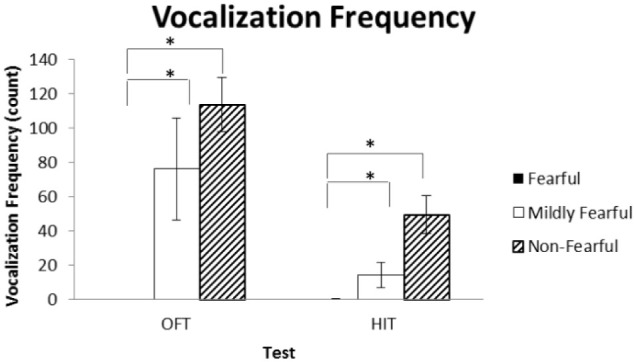
Effect of fear rating on vocalization frequency in the open-field test (OFT) and human interaction test (HIT). Bars represent SEM. *P <0.05
Effect of fear rating on HIT behavior
There was a highly significant effect of fear on distance travelled (F[2,38] = 7.18924; P <0.005), with fearful animals showing significantly less movement than non-fearful and mildly fearful animals (P <0.005 and P <0.05, respectively; see Figure 3) and on inactivity duration (F[2,38] = 10.8233; P <0.001), with non-fearful animals having significantly shorter inactivity durations compared with fearful (P <0.001) and mildly fearful (P <0.01) cats (see Figure 1). The other state variables were not significantly different.
Figure 3.
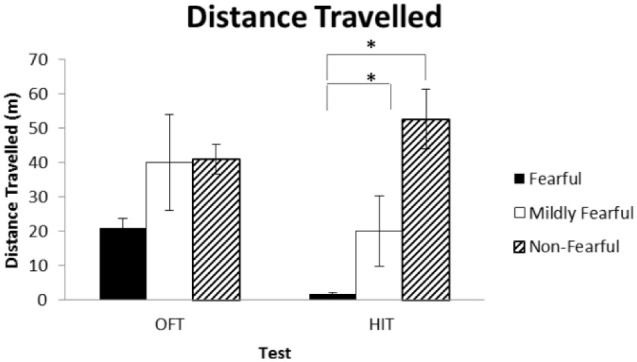
Effect of fear rating on distance travelled in the open-field test (OFT) and human interaction test (HIT). Bars represent SEM. *P <0.05
There were significant findings in the following events: inactivity frequency (F[2,38] = 12.43844; P <0.0001), vocalization frequency (F[2,38] = 5.0177; P <0.05) and near human frequency (F[2,38] = 4.026898; P <0.05). For inactivity frequency, non-fearful cats had significantly more inactive bouts compared with fearful (P <0.0001) and mildly fearful (P <0.01) cats (Figure 4). For vocalization frequency, non-fearful and mildly fearful cats showed significantly more vocalization than fearful cats (P <0.01 and P <0.05, respectively; see Figure 2). Finally, in near human frequency, non-fearful and mildly fearful cats approached the human significantly more times than the fearful cats (P <0.05). None of the fearful cats approached the human.
Figure 4.
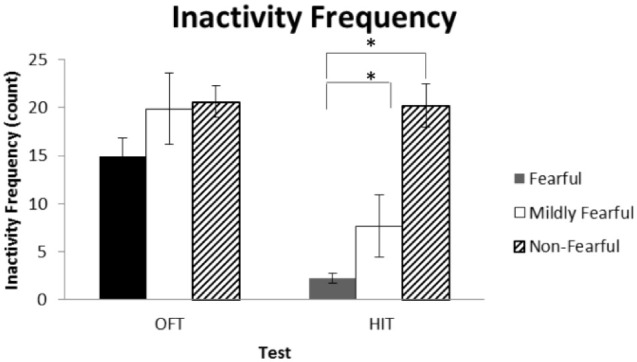
Effect of fear rating on inactivity frequency in the open-field test (OFT) and human interaction test (HIT). Bars represent SEM. *P <0.05
Comparison between OFT and HIT
For distance travelled, there was a significant main effect of fear rating (F[2,38] = 6.12203; P <0.005) and a significant interaction between test and fear rating (F[2,38] = 3.91515; P <0.05). Overall distance travelled was significantly greater in the non-fearful compared with the fearful cats (P <0.005). Both fearful and mildly fearful cats travelled less in the HIT. For the duration of inactivity measure, there were significant main effects of fear rating (F[2,38] = 8.7967; P <0.001) and test (F[1,38] = 12.2845; P <0.005), as well as a significant test by fear rating interaction (F[2,38] = 5.2695; P <0.01). This was owing to the fearful and mildly fearful animals having significantly longer periods of inactivity duration compared with the non-fearful group (P <0.001 and P <0.05, respectively). The test effect was due to significantly shorter inactivity duration during the OFT in comparison with the HIT (P <0.05), which was driven by the fearful and mildly fearful groups; the non-fearful cats showed little change.
An RM-ANOVA was conducted for inactivity frequency. There were significant effects of fear rating (F[2,38] = 8.5969; P <0.001) and test (F[1,38] = 19.5717; P <0.0001). The fear rating effect was due to non-fearful animals being inactive significantly more often compared with fearful (P <0.001) and mildly fearful animals (P <0.05). The test effect was due to significantly higher inactivity frequency during the OFT compared with the HIT (P <0.01). The test by fear rating interaction for inactivity frequency was due to inactivity frequency decreasing significantly during the HIT in fearful (P <0.01) and mildly fearful (P <0.01) animals. Inactivity frequency did not change across tests for the non-fearful cats.
Analysis of vocalization frequency revealed a significant effect of fear rating (F[2,38] = 8.02150; P <0.01) and test (F[1,38] = 15.09072; P <0.001). The fear rating effect was a result of lower vocalization in fearful animals when compared with the mildly fearful group (P = 0.001). The test effect reflected lower overall vocalization in the HIT in non-fearful (P <0.0001) and mildly fearful animals (P <0.005).
Experiment 2: effects of diazepam on fearful, mildly fearful and non-fearful cats
The open-field analyses revealed statistically significant main effects on the following states: distance travelled (F[1,9] = 26.07247; P <0.001) and inactivity duration (F[1,9] = 42.1812; P <0.001). The results reflected increased distance travelled and shorter inactivity duration (Figures 5 and 6). Also, there were statistically significant main effects on the following events: inactivity frequency (F[1,9] = 9.53058; P <0.05) and vocalization frequency (F[1,9] = 10.72972; P <0.01). Both inactivity and vocalization were more frequent during the diazepam treatment condition (Figures 7 and 8). There was no significant effect of fear rating on any of the state or event variables.
Figure 5.
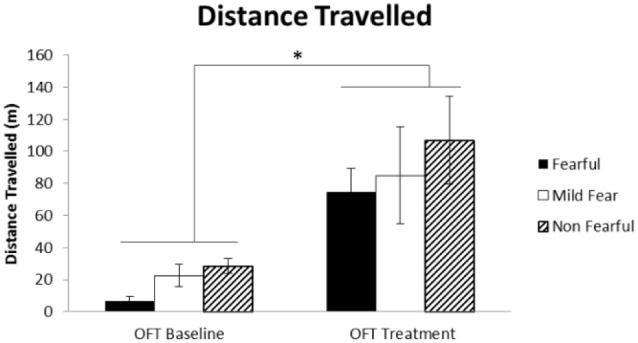
Effect of diazepam treatment on distance travelled in the open-field test (OFT). Bars represent SEM. *P <0.05
Figure 6.
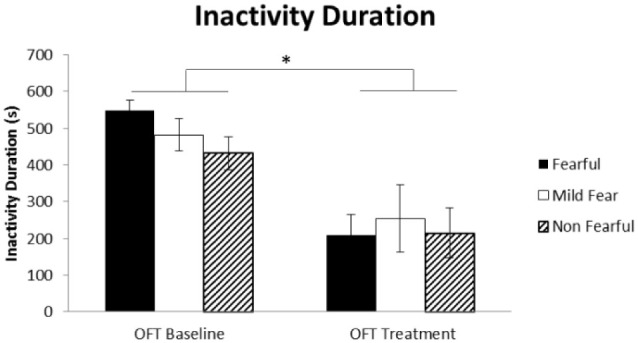
Effect of diazepam on inactivity duration in the open-field test (OFT). Bars represent SEM. *P <0.05
Figure 7.

Effect of diazepam on inactivity frequency in an open-field test (OFT). Bars represent SEM. *P <0.05
Figure 8.
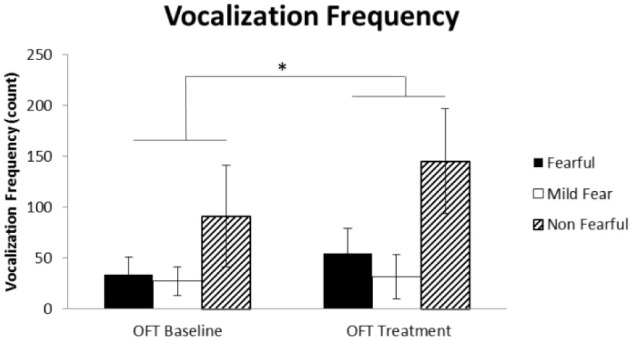
Effect of diazepam on vocalization frequency in an open-field test (OFT). Bars represent SEM. *P <0.05
In the HIT, there was also a significant effect of treatment on the following states: distance travelled (F[1,9] = 9.98282; P <0.05), with cats travelling more when given diazepam compared with baseline and inactivity duration (F[1,9] = 10.0984; P <0.05), and with cats having shorter bouts of inactivity when given diazepam. There were no significant effects of treatment on any of the event variables. Lastly, there was a significant effect of fear rating in the event variable, near human frequency (F[2,9] = 5.8220; P <0.05), with fearful animals frequenting near the human the least and non-fearful animals the most (P <0.05). There were no other significant effects of fear rating on the other event variables or any of the state variables.
Discussion
This study sought to develop and validate a laboratory-based protocol for assessing fear and anxiety in cats. The behavior of the cats in two assessment models, an OFT and an HIT, was compared with their fear rating, which was initially assessed by observing the cat’s response in its home environment when approached by known and unknown persons. In experiment 2, the responses of the cats when treated with diazepam in the same assessment models was observed.
The OFT assesses exploratory behavior in an empty room, which we suggest can be used to assess anxiety, while the HIT focuses on the response to the presence of a person, in this case an unfamiliar person, which is a stimulus for fear. Both tests were carried out in the same procedure room. When the tests were compared, there were three main findings. First, the cats’ responses in the OFT differed from the responses in the HIT, suggesting the OFT provided a measure of anxiety, likely due to separation from social group and an unfamiliar environment rather than fear. Second, the fear rating significantly affected how the cats responded to both anxiety and fear provoking situations. Third, the response to diazepam treatment reduced some aspects of anxiety, such as an increase in distance travelled, but did not affect fear of the unfamiliar person.
The hypothesis that the OFT assesses anxiety and the HIT assesses fear is supported by differences in distance travelled and inactivity between the two tests. Compared with HIT, distance travelled was greater in the OFT and inactivity was decreased. Another differentiating behavior was vocalization. More vocalizations (ie, meows) were observed in the OFT than in the HIT.
The results also showed that the individual fear rating affects the response of cats to an anxiety-provoking situation. Fearful cats showed very little vocalization in either the OFT or HIT; non-fearful animals, by contrast, showed a marked increase in vocalization in the OFT. The increased vocalization (meows) in the non-fearful cats might be due, in part, to anxiety associated with the unfamiliar barren environment, and separation from their social group, which was suppressed in the fearful cats. Fearfulness also affected the animals’ responses in the HIT. Although the cats in the fearful, mildly fearful and non-fearful groups did not differ in activity and inactivity in the OFT, the groups did respond differently in the HIT, with fearful cats showing less movement than mildly fearful and non-fearful cats. Fearful and mildly fearful cats also had greater durations of inactivity and lower frequency of inactivity than non-fearful cats. Thus, fearful and mildly fearful cats were silent and still during the HIT, while non-fearful cats were vocal and active.
Treatment with diazepam resulted in significant increases in both distance travelled and vocalization in the OFT across all groups, which is consistent with the suggestion that diazepam has anxiolytic effects. It is also possible, however, that the increases in activity are a direct effect of diazepam, which has been reported at dose levels higher than used in this study. 21
The increased vocalization was unexpected but appeared to be a robust phenomenon. One possibility is that it reflects a reduction in the high level of anxiety, or behavioral disinhibition, triggered by placement in the open field. This assumes that vocalization may be enhanced in a moderately fearful situation but suppressed in a highly fearful situation. Another interpretation is that the vocalization is a paradoxical effect of diazepam therapy. As a similar increase in vocalization was not observed in the HIT, this may indicate that the diazepam was unable to overcome the suppressive effect of the unfamiliar human, as demonstrated by the overall decline in vocalization in experiment 1. A limitation of this study, however, is the small sample size. A follow-up study should be conducted to determine how robust the findings are when a larger number of cats are being tested.
Conclusions
Developing medications and other therapies to aid in managing anxiety disorders in cats is hampered by the lack of validated models for assessing these emotions. Fear and anxiety are two separate, but closely related, emotions. This study showed that the OFT and HIT can be used jointly in a laboratory setting to determine the differential effects of medications and other therapies on anxiety and fear.
Footnotes
Bill Milgram and Gary Landsberg are employees of CanCog Technologies, and Christina de Rivera is an employee of Vivocore, the company subcontracted to conduct the study.
Funding: The authors received no financial support for the research, authorship, and/or publication of this article.
Accepted: 8 March 2016
References
- 1. Seibert LM, Landsberg GM. Diagnosis and management of patients presenting with behaviour problems. Vet Clin North Am Small Anim Pract 2008; 38: 937–950. [DOI] [PubMed] [Google Scholar]
- 2. Serpell JA. Evidence for an association between pet behavior and owner attachment levels. Appl Anim Behav Sci 1996; 47: 49–60. [Google Scholar]
- 3. Beata C, Beaumont-Graff E, Coll V, et al. Effect of alpha-casozepine (Zylkene) on anxiety in cats. J Vet Behav Clin Appl Res 2007; 2: 40–46. [Google Scholar]
- 4. Pryor PA, Hart BL, Cliff KD, et al. Effects of a selective serotonin reuptake inhibitor on urine spraying behaviour in cats. J Am Vet Med Assoc 2001; 219: 1557–1713. [DOI] [PubMed] [Google Scholar]
- 5. Landsberg GM, Wilson AL. Effects of clomipramine on cats presented for urine marking. J Am Anim Hosp Assoc 2005; 41: 3–11. [DOI] [PubMed] [Google Scholar]
- 6. Orlando JM, Case BC, Griffith E, et al. Use of oral trazodone for sedation in cats: a pilot study. J Feline Med Surg 2016; 18: 476–482. [DOI] [PMC free article] [PubMed] [Google Scholar]
- 7. Bear MF, Connors BW, Paradiso MA. Neuroscience: exploring the brain. 3rd ed. Baltimore, MD: Lippincott Williams and Wilkins, 2007, pp 665–669. [Google Scholar]
- 8. Landsberg GM, Hunthausen W, Ackerman L. Behavior problems of the dog and cat. 3rd ed. Edinburgh: Saunders Elsevier, 2013. [Google Scholar]
- 9. Cooper L. Fears, phobias and anxieties – cats. In: Smith WK, Jr, Tilley LP. (eds). Blackwell’s five-minute veterinary consult: canine and feline. 6th ed. Ames, IA: Wiley Blackwell, 2016, pp 488–489. [Google Scholar]
- 10. Prut L, Belzung C. The open field as a paradigm to measure the effects of drugs on anxiety-like behaviours: a review. Eur J Pharmacol 2003; 463: 3–33. [DOI] [PubMed] [Google Scholar]
- 11. Boissy A, Bouissou MF. Assessment of individual differences in behavioural reactions of heifers exposed to various fear-eliciting situations. Appl Anim Behav Sci 1995; 46: 17–31. [Google Scholar]
- 12. Seaman SC, Davidson HPB, Waran NK. How reliable is temperament assessment in the domestic horse (Equus caballus)? Appl Anim Behav Sci 2002; 78: 175–191. [Google Scholar]
- 13. Villalba JJ, Manteca X, Provenza FD. Relationship between reluctance to eat novel foods and open-field behavior in sheep. Physiol Behav 2009; 96: 276–281. [DOI] [PubMed] [Google Scholar]
- 14. Siwak CT, Tapp PD, Milgram NW. Effect of age and level of cognitive function on spontaneous and exploratory behaviors in the beagle dog. Learn Mem 2001; 8: 317–325. [DOI] [PMC free article] [PubMed] [Google Scholar]
- 15. Siegford JM, Walshaw SO, Brunner P. Validation of a temperament test for domestic cats. Anthrozoos 2003; 16: 332–351. [Google Scholar]
- 16. Blanchard DC, Griebel G, Blanchard RJ. The mouse defense test battery: pharmacologic and behavioral assays for anxiety and panic. Eur J Pharmacol 2003; 46: 97–116. [DOI] [PubMed] [Google Scholar]
- 17. Blanchard RJ, Griebel G, Henrie J, et al. Differentiation of anxiolytic and panicolytic drugs by effects on rat and mouse defense test batteries. Neurosci Biobehav Rev 1997; 21: 783–789. [DOI] [PubMed] [Google Scholar]
- 18. McNaughton N, Zangrossi H, Jr. Theoretical approaches to the modeling of anxiety in animals. In: Blanchard RJ, Blanchard DC, Griebel G, et al. (eds). Handbook of behavioural neuroscience. Vol 17. Amsterdam: Elsevier, 2008, pp 11–27. [Google Scholar]
- 19. Blanchard DC, Blanchard RJ, Rodgers RJ. Diazepam changes risk assessment in an anxiety/defense test battery. Psychopharmacology (Berl) 1990; 101: 511–518. [DOI] [PubMed] [Google Scholar]
- 20. Sherman BL, Mills DS. Canine anxieties and phobias: an update on separation anxiety and noise aversions. Vet Clin North Am Small Anim Pract 2008; 38: 1081–1106. [DOI] [PubMed] [Google Scholar]
- 21. Rasmussen K, Jacobs BL. Single unit activity of locus coeruleus neurons in the freely moving cat. II. Conditioning and pharmacologic studies. Brain Res 1986; 371: 335–344. [DOI] [PubMed] [Google Scholar]


